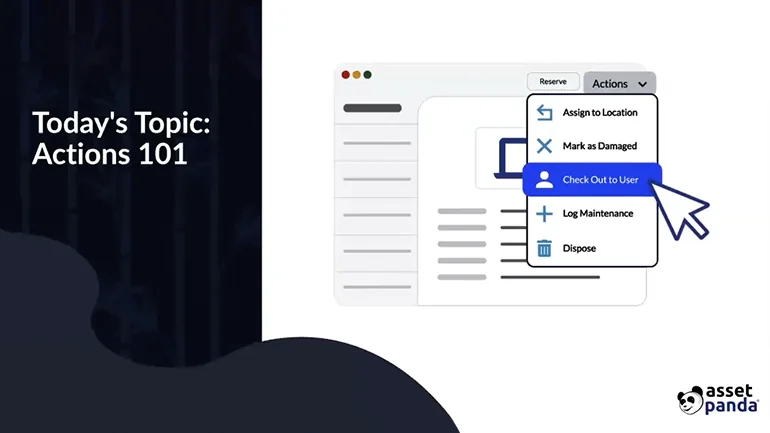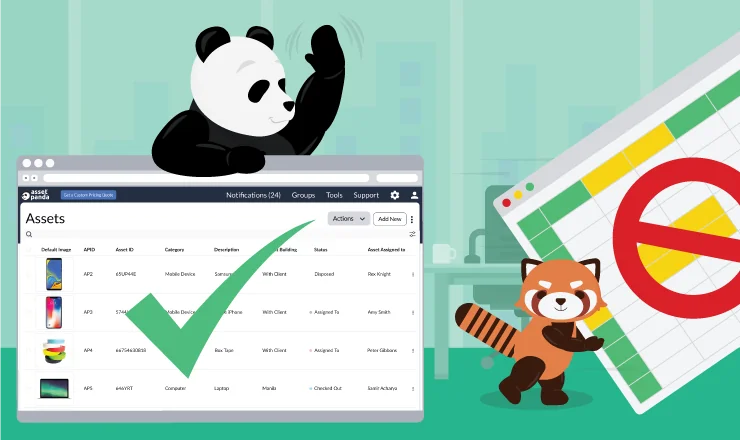What is Single Sign-On (SSO) & How Does Asset Panda Work with OneLogin?

Asset Panda is a highly rated asset management platform not only because of what we have to offer on our own, but also because of the powerful integrations we provide that connect with the most popular business operations platforms and digital security tools on the market.
One of our users’ favorite integrations is our connection with OneLogin, the secure single sign-on solution that makes using Asset Panda securely easier than ever.
Here’s a guide to what exactly we mean when we say single sign-on, how SSO solutions work, and how OneLogin integrates seamlessly with Asset Panda.
What is Single Sign-On (SSO)?
Single sign-on, also known as SSO, is a form of security that allows a user or series of users to securely sign in to multiple websites, platforms, and applications with a single, unified username/password combination. Essentially, think of single sign-on as a master key that will get you into any of the secure locations you use on a regular basis.
We know what you’re thinking— isn’t it a little dangerous having one password for all of your accounts? In fact, single sign-on actually increases security while also boosting convenience and saving organizations time and money along the way.
Let’s explore everything you need to know about single sign-on, including how it works, its benefits, and how it can integrate seamlessly with Asset Panda to make your asset management more streamlined, secure, and efficient than ever.
How Single Sign-On Works
Single sign-on works through a partnership between the SSO provider and the service provider, or whichever website, platform or application a user is trying to access.
Here’s how the process tends to look step-by-step.
First, a user navigates to and arrives at the website, software application, or other digital destination that requires secure access. Then, the service provider— whoever owns the website or application— sends a token to the single sign-on system. A token in this case is some piece of identifying information, such as an email address, used to help authenticate the user. From there, the single sign-on system automatically checks whether the user has been authenticated already. If they have been, they’ll be sent right through to the service provider. If not, they’ll be asked to provide their credentials by the single sign-on provider— usually just a username or password, but sometimes accompanied by a single-use password sent to a secondary device.
Once the credentials have been validated, a token is sent from the SSO service to the website or app provider confirming that the user has been authenticated, the token is validated, and the user is granted access.
This may sound like a lot of steps, but it all happens seamlessly in a matter of seconds for the user.
Benefits of SSO
Enhanced security isn’t the only benefit of single sign-on. Here are some of the other benefits of SSO that can help make your organization more streamlined, secure, and efficient on a daily basis.
Avoid Repeat Passwords
Repeated passwords can often lead to serious security risks, particularly when those passwords are simple and easily guessed. In many cases, people will use the same passwords for many of their accounts— and that password is usually something straightforward and easy to remember. With these repeated passwords, a hacker successfully discovering one means they can discover them all. Research shows that nearly 60% of people use the same password for multiple accounts or a similar password.
Using a single sign-on system such as OneLogin with Asset Panda means that passwords don’t have to be repeated, and the single sign-on password can be more complex and difficult to crack because it’s the only password users have to remember on an ongoing basis.
Make Passwords Stronger without Inconvenience
One of the main questions that users that are new to SSO have is: Doesn’t having just one password make it easier for a hacker to gain access to all of my accounts?
If you use a simple, easy-to-guess password for your SSO credentials, that may be true. But single sign-on is most effective when that single password is as strong as possible. And because SSO allows users to use just a single password to access their many accounts, this doesn’t have to be an inconvenience.
Think of all of your accounts as a walled city with different buildings. Each building has its own simple lock that offers some level of security. But the single sign-on system and password are like a thick wall with a massive locked door around the outside, encircling all the buildings. This adds an additional layer of more powerful security, while still only requiring one key to access for those who are allowed to enter.
Make Security Policies Easier to Manage & Enforce
With single sign-on, your company’s secure access policies with Asset Panda instantly become more straightforward. That means that your employees can understand and follow them more easily, and it also means that they’re much easier to enforce on a regular basis.
Instead of having to follow a complex series of varying security policies that change based on the application and context, users must simply remember their login credentials for SSO, which will then automatically log them out at the end of their session. This also helps with compliance, for certain regulations such as HIPAA require that accounts are logged out after each individual point of access in order to remain compliant.
Easily Provide Multi-Factor Authentication
Multi-factor authentication has become one of the most common and most secure ways to add a layer of security between hackers and various platforms or accounts. Multi-factor authentication works by combining a user’s credentials (username and password) with a physical device they must have in their possession in order to gain access.
In practice, you’ve probably used multi-factor authentication before. Think of when you log in to a platform and before it grants you access, it sends a special code to the cell phone number you have on file. Entering that code grants you access in addition to your username and password.
But having to use multi-factor authentication for multiple accounts over the course of the day can waste time and cause frustration. With SSO, multi-factor authentication can be used for added security while only being required once to be able to access multiple different systems.
Eliminate Frustration & Wasted Time
The more apps and platforms employees manage, the more login credentials they have. When that’s the case, you want them to all have unique passwords in order to enhance security. The downside is lots of lost passwords and IT time spent helping employees recover those lost passwords. That adds up to real costs for businesses, not to mention the time that employees can’t work because they can’t access their accounts. SSO helps reduce time wasted on password recovery and increase productivity throughout your organization.
Move Password Storage Inside Your System, Not Outside
One of the best benefits of single sign-on has to do with where password information is stored. In a traditional system, the passwords of users are stored at a remote or cloud-based location by the applications or services that require those passwords, and you can’t rely on each of those platforms to have the best security practices. Some might, but it’s outside of your control.
With single sign-on available through OneLogin and Asset Panda’s close integration, credentials are stored internally within your organization and your IT team has control over their storage, access, and security.
Reduce Hacker Access Points
Every time a user has to log in to a specific application, such as Asset Panda, it’s an opportunity for a hacker to gain access as well. With single sign-on through OneLogin, users only log in once per day, reducing the amount of opportunities for hackers, and they use a single set of credentials that doesn’t give hackers access to their other accounts.
Is Single Sign On Secure?
Single sign-on can be extremely secure if it’s used properly by organizations that implement it. For example, a single sign-on solution helps make username and password management simpler, allows for more complex passwords that are more difficult to crack, and cuts down on the amount of access points potential hackers can use to gain access into a platform or database.
In special cases where additional security is required, companies may want to add elements such as multi-factor authentication or restricted access for those who aren’t on a secure network.
How SSO Works with Asset Panda
Wondering how single sign-on with OneLogin integrates with Asset Panda to make your asset management safer, easier, and more secure? Here are some of the core features of one of our most popular integrations.
Directory Integration
Asset Panda is capable of connecting seamlessly with Active Directory, LDAP, Google, HCM systems, and OneLogin, allowing you to grant and revoke access in real-time without requiring changes to your firewall.
OneLogin Mobile Identity
By integrating with OneLogin mobile, you’ll get access to all enterprise-level and cloud-enabled applications. Access any apps on any device while eliminating security risks for enterprises.
SAML Single Sign-On
Eliminate user-managed passwords and enable OneLogin to securely sign-in users on Asset Panda, either from the OneLogin portal or your company’s entranet.
Compliance Reporting
With centralized access control, you benefit from a clear audit trail paired with the customizable reports provided by OneLogin.
Ready to take advantage of Asset Panda’s integration with OneLogin and other powerful features? Try a free Asset Panda demo today!
Related News & Press

Learn more from an Asset Panda expert
Get a FREE consultation with an asset tracking expert to find out how you can transform your asset tracking


